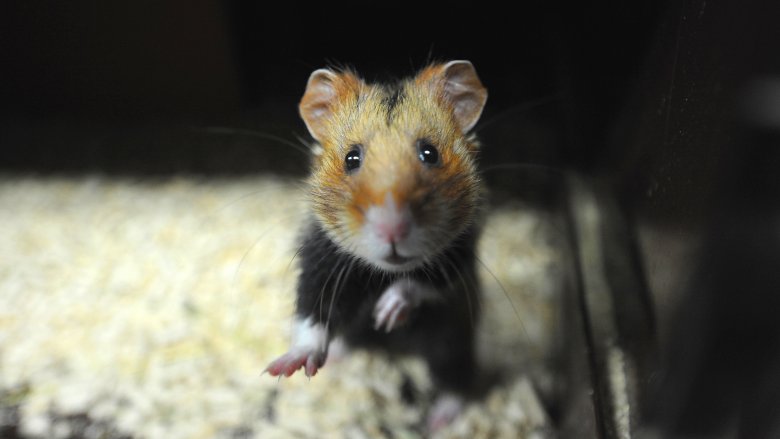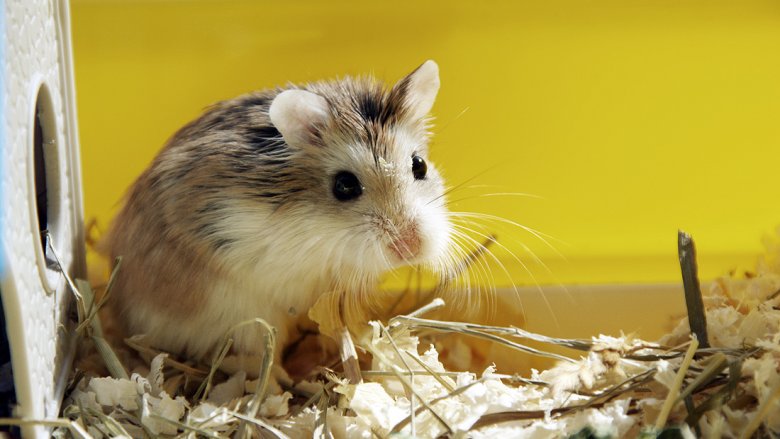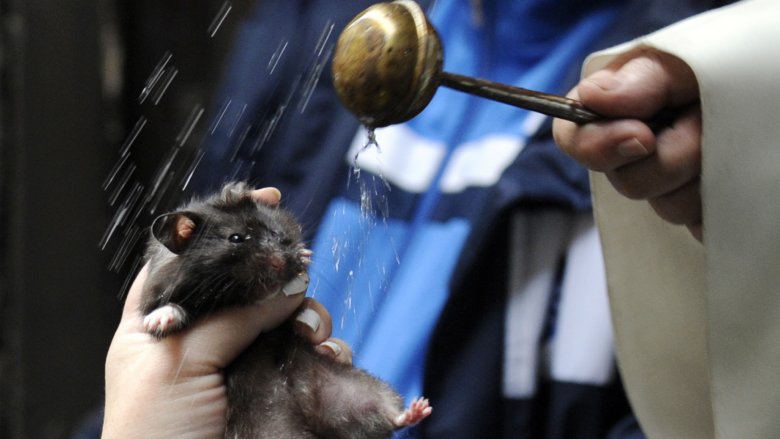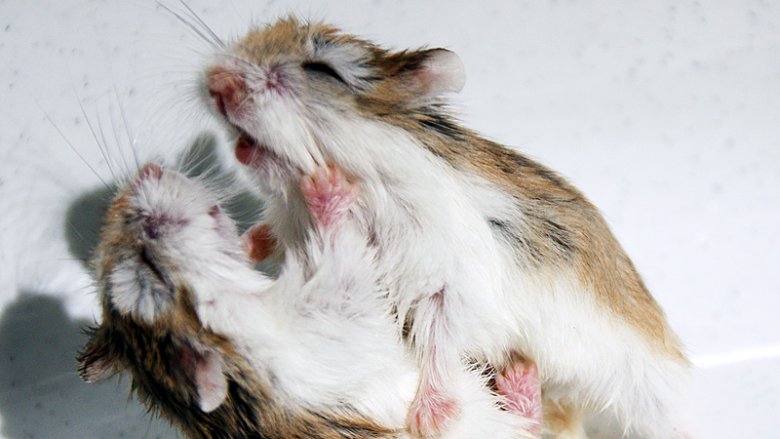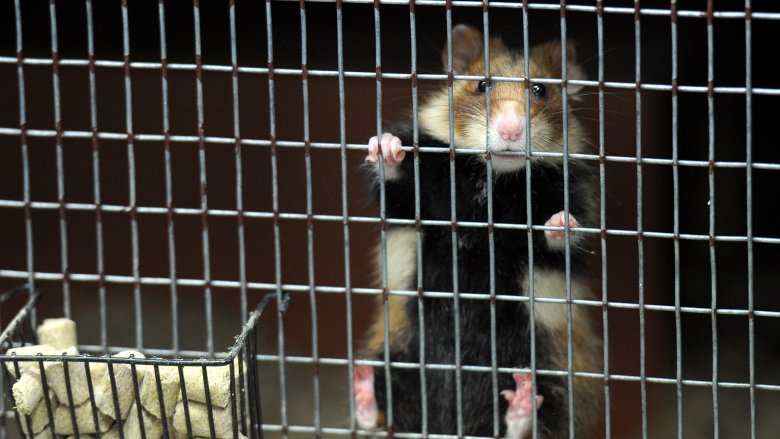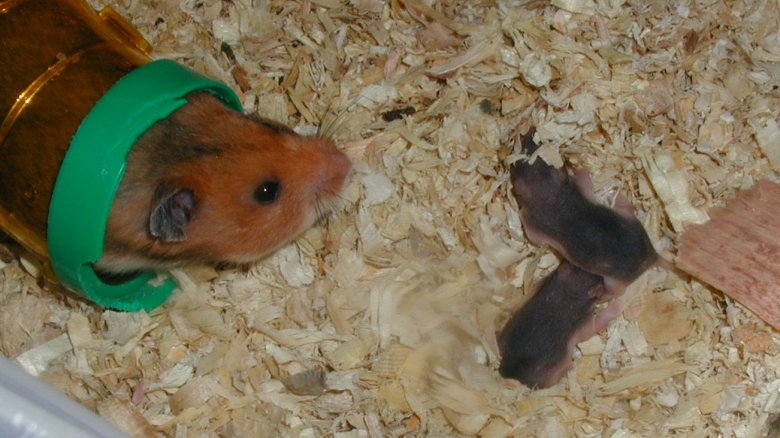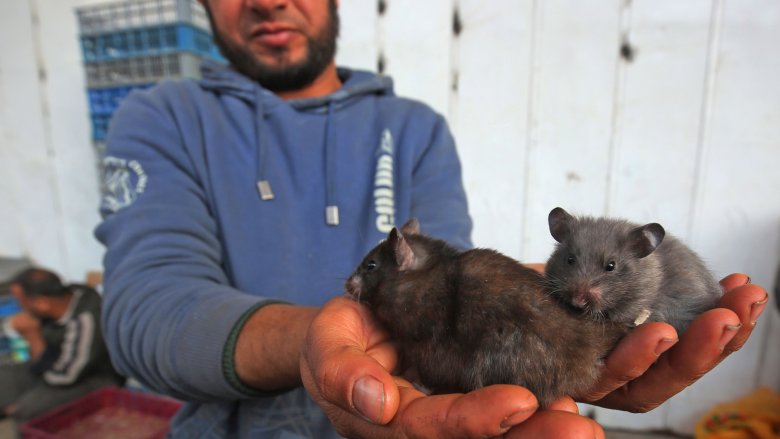The Dark, Disturbing Truth Of Hamsters
Hamsters are incredibly popular pets, especially as "starter pets" for kids whose parents don't feel they're ready for the responsibility of a larger, more difficult pet that would cause more of an uproar with the neighbors if the kid does a bad job taking care of it. The most common domestic hamster by far is the Syrian or golden hamster, also called the fancy hamster, if you want to gild the lily a little. Various species of dwarf hamster are also common as pets, including the Roborovski hamster, known colloquially as the Robo, despite not being a cool cybernetic hamster of the future. The Chinese hamster is less common as a pet, partially because of the male's large and conspicuous genitals, which can grow to be as large as their head.
Enormous business notwithstanding, hamsters are famed for being cute little balls of fuzz who just run on their wheels or in their plastic balls and lap beads of water out of their little water bottles and dig around in wood chips and what have you. But underneath that cute exterior lies a miserable pile of dark secrets. Hamsters, it turns out, are blind, alcoholic, inbred, murderous, cannibalistic cranks. Read on to learn the horrific truth of these sinister rodents you voluntarily welcome into your home.
Cannibalistic Hamsteroid Underground Dwellers
For humans, one of the strongest natural emotional forces is the protective instinct a mother feels toward her children. It's what drives the entire bustling "Mama Bear" car decal industry. So that's why it's so shocking for many people to find out that it's actually not all that uncommon for a mother hamster to kill and eat her babies.
There are a number of reasons why this might happen: stress caused by the size of the litter, fear of the environment (especially if some goony human pokes too close or too often around a hamster cage with a litter of pups in it), a human's scent getting on the babies and confusing the mom so that she doesn't recognize her own offspring, insufficient food, or just because the mother feels overwhelmed and worries she won't be able to provide for or protect her babies. It's an act of mercy, not just some case of sudden cannibalistic munchies. In that context, it's much clearer that a hamster mother eating her babies is actually a different manifestation of that same protective maternal instinct that human mothers feel, and it's maybe a little easier to understand. But all that understanding falls away again when you read about how hammy moms sever their pups' heads. Respect and understanding, man. They are hard won, but sadly can be lost by something as small and inconsequential as eating your own child's head.
Well, the teeth start growing and they don't stop growing
Hamsters are rodents, and there's one thing that ties all rodents — as well as related species like rabbits and hares — together, and that's the fact that their incisors (front teeth) grow continuously over the span of their life, like some kind of terrible tooth nightmare. Just, like, an infinity of teeth, forever. Normally, the teeth stay a normal length because rodents gnaw at their food (the word "rodent" means "gnawing") and they're naturally ground down in that process. Yes: that is also gross, and not a great alternative to the mental image of infinity long teeth.
But what happens if their teeth don't get properly ground down in the normal eating process? As Spruce Pets explains, the teeth might become overgrown and curve into their gums, get caught on things, cause drooling, hyperventilating, and cause problems with swallowing. These are all terrible and gross things to imagine, so how do you fix it? Well, with another terrible and gross thing: trimming your hamster's teeth. The good news is that this is a simple horrific process you can do with simple tools you already have in your house whose memory will be forever tainted by this foul dental deed. No need to use a dremel tool like you might with a larger animal like a rabbit or chinchilla (blargh), just use suture scissors or a pair of fingernail clippers and try not to think about the amateur veterinary dental surgery you did next time you clip a hangnail.
Blind as bats
The hamster is a crepuscular (meaning active during the hours of dawn and dusk), burrowing animal that lives underground. As such, a good sense of sight is about as useful to them as a neverending pasta pass at Olive Garden. While hamsters can see okay in dim light, in bright light they're basically blind. Baby hamsters are blind at birth, and as adults they can only ever see a few inches in front of their nose. A hamster's main methods of getting around are using their other senses, such as hearing, smell, and touch via their whiskers.
The bad news is that this bad vision poses a number of dangers for pet hamsters as well as their owners. These Mister Magoos of the animal kingdom are known to walk off high surfaces or jump out of hands or off shoulders and hurt themselves or worse. (The lesson here is don't perch your hamster on your shoulders or hold them in your hand while standing up. Also don't buy them multi-level cages or, you know, put them on high surfaces, even if you think it would be cute to put them on the ceiling fan blade, even if the fan is on low.) Hamsters' poor vision is also the main cause for biting, as sudden moves frighten them, and if they don't catch or recognize their owner's scent, they might bite defensively at the unknown giant blob trying to shove them into a ball.
They're like chocoholics, but for booze
Despite the clear classification of hamsters as rodents, the Syrian hamster seems to have a little canine DNA in its genome as well: they're half hamster, half booze hound. According to the New York Times, hamsters are popular with alcohol researchers because those little dudes are nuts for hitting the sauce. Given the choice between drinking from a bottle of water and a bottle of alcohol, they will choose the alcohol 100 percent of the time. They love it.
How did hamsters develop their adorable, pocket-sized version of dipsomania? It's related to their instinct for hoarding. They bury fruit to store all summer, and when they come back to it in wintertime, the fruit has fermented and the hamsters get turnt in their hibernal bunkers. As a result, they've come to prefer and even seek out the smell and taste of fermented fruit because that fruit is easier to find by scent.
It turns out they can handle their liquor better than humans, though. Their liver is developed enough to metabolize large (well, large relative to their size) servings of alcohol. In terms of size relation to their other organs, a hamster's liver is five times the size of a human's. You know, proportionately. Not literally, as that would be both weird and impossible. Just a little mouse-sized dude dragging around a 15-pound digestive organ? It wouldn't even fit in their little exercise ball.
No trespassing
The popular early 2000s manga and anime Hamtaro centered around the titular Hamtaro, a hamster who would meet up with his hamster friends the Ham-Hams in their special hamster clubhouse and have cool hamster adventures. Bad news, anime fans. If the show were more realistic, Hamtaro would murder each Ham-Ham he encountered in order to have the clubhouse all to himself.
It turns out hamsters, especially Syrian hamsters, are super mega territorial. While it's not uncommon to see hamsters caged together at pet stores, it's because hamsters in stores are usually really young. Once hambos hit about 8 to 10 weeks of age, you have to keep them apart or they will fight it out until one or both are dead, like those guys with switchblades who strapped their wrists together in the "Beat It" video. Even if they don't fight, close proximity between adult hamsters will cause enough stress to significantly shorten their life spans. The only time adult Syrian hamsters should be together is when they're mating, basically, but even then it's an uneasy truce that is short-lived at best. If you have multiple Syrian hamsters, you have to keep them in separate cages and they should have their own toys.
Not all types of hamsters are insufferable solitary hermits, though. Dwarf hamsters can get along with same-sex roommates if they're paired together from a young enough age. But even this is unreliable. They're just grumpy old coots, man. Loners, Dottie. Rebels.
Despite all my rage
Hamsters are by and large solitary, territorial creatures who like to spread out over their own personal territory, exploring and foraging and burrowing where they so please. It turns out, then, that they don't ... love it when humans coop them up in tiny cages and leave them there to rot in their tiny plastic Shawshanks without even a Rita Hayworth poster for company. Keeping your hamster in a too-small space can lead to a fake-sounding-but-real condition known as "cage rage," which can cause your hamster to basically hulk out and smash puny human.
Symptoms of cage rage include hour-long sessions of biting at their cages, biting and attacking people who get too close, peeing everywhere to mark territory, increased aggression and attacking literally anything, destroying their own toys, berserker rage, squealing and spitting, restlessly climbing around their cage, ruined teeth from all their stress biting, and just, like, general anxiety. Syrian hamsters, being relatively large and extra territorial, are most at risk of cage rage; Robo hamsters are small enough that they're at relatively low risk, but even they can suffer from stress itching if their environment is too small. In bad enough cases, a hamster might never recover from cage rage, and yikesamundo. That's no fun for anyone.
The solution is to make sure your hamster has a suitably large living space with lots of toys and gets plenty of time in its hamster ball to explore and exercise. A Rita Hayworth poster probably couldn't hurt, though.
There's no off switch on the baby-making machine
If you have a hamster and feel like that isn't enough, having two hamsters is a good way to get a million hamsters because these cute little fluffs are actually unstoppable baby-making machines. A Syrian hamster can get preggo at just four weeks old, and then a female hamster will come into heat — that is, become receptive to mating — every four days. For comparison's sake, most dogs come in heat two or three times a year. You can tell your hambo is in heat because she will give off a strong, hormonal odor that will serve as a musky and unwanted reminder of your tiny month-old friend's budding sexuality.
If a boy hamster and a girl hamster get together long enough to mate without killing each other, you can expect a litter of hamster pups in about 18 to 22 days depending on the variety of ham you have. The litter will likely be between 3 and 12 pups, depending on the hamster type, though a Syrian hamster uterus can hold up to 24 little miracles. If this isn't enough babies for you, great news! Dwarf hamster females come back into heat immediately after giving birth, so just refill that furry little mama like a PEZ dispenser full of babies and you'll have another dozen pups in less time than it takes for an issue of Southern Living magazine to come out. (Absolutely do not breed your hamster two cycles in a row, you monster. Also adopt, don't breed. There are enough hamsters.)
Bad marketing
If you were to look up fun hamster facts online — a cool, normal way to spend your weekend — one you'd probably see repeated on various sites is that the word "hamster" comes from the German verb "hamstern" meaning "to hoard." Nope! It's the other way around. The verb comes from the name of the animal, similar to how in English we refer to people "squirreling something away." Imagine being so associated with hoarding that an entire language named it after you. "No, don't go to his house, he's a real Davider. There's newspapers everywhere." "Coming soon to TLC, Rachelers Season 12. How many commemorative Spock plates can one woman Rachel?"
According to the Online Etymology Dictionary, the truth is that the word "hamster" likely comes from a blend of Eastern European words indicating a small ground rodent, including the Russian chomiak, meaning, well, "hamster," and a Baltic word such as the Lithuanian staras, meaning "ground squirrel." So, alas, nothing to do with pigs or amateur radio. Alternatively, the word might come from a Persian word meaning "oppressor," which seems like an over-the-top kind of thing to call a cute, blind-ish, furball, but if you cause enough trouble for Persian farmers, who knows what they might call you.
But wildest of all, they weren't even always called hamsters in English. The former common term for them was "German rat" due to how plentiful they were in Europe. Presumably the name was changed to its cuddlier modern incarnation for marketing and PR purposes.
It's Adam and Eve, not Adam and Mister Saddlebags
Hamsters — specifically Syrian hamsters — are ubiquitous as pets now, but they were only really domesticated in the 1930s thanks to the work of Jewish biologist Israel Aharoni, who wanted to give Hebrew names to all the animals of the Holy Land, matching them up to names of animals in the Torah when possible. As Smithsonian magazine explains, in 1930, he went searching the hills of Syria for a small, golden rodent that he had heard rumors of, which was known in Arabic by the truly embarrassing name of Mister Saddlebags (this is a translation, of course).
Aharoni's motivation wasn't just to replace the ridiculous-if-endearing Mister Saddlebags with the relatively sedate sounding Hebrew oger, however. He and his colleagues also thought that Mister Saddy-B might be close enough physiologically to humans to be of use in medical research, so when he uncovered a mother ham and her ten pups, he took them back to Jerusalem. Well, long story short, after a series of hilarious and horrifying antics that involved most of the hams eating each other and Aharoni drowning the mother in cyanide, he had a single mating pair left who soon blessed him with 150 more ham babies, who then themselves bred and gave rise to tens of thousands of offspring. And every domestic Syrian hamster on Earth arose from this brother and sister hamster Adam and Eve pair in a laboratory in Jerusalem. Every hamster owner has a descendant of the original Mister Saddlebags rolling around their house.
Sometimes, the Hamster Dance is a crime
Everyone knows that hamsters' most marketable skill is their penchant for forming dance crews. Once you see a hamster dance, you'll never get it out of your head. And so it only makes sense that eventually a hamster dance crew would hit it big promoting the Kia Soul, a sensible five-door subcompact crossover multi-purpose vehicle. The only surprising part is that somehow these hamsters were big enough to drive a human-sized hatchback. Maybe they shrunk the cars with CGI or something, who knows.
Anyway, as with any sufficiently meteoric rise to fame, a fall was sure to follow. As the Los Angeles Times reported in 2016, one of the humans behind the dancing Kia hamsters, Leroy Barnes, was sentenced to electronic monitoring, community service, and over $24,000 in fines for insurance fraud and making false statements. Barnes was injured in 2010 when a piece of ceiling fell on him and a doctor put him on temporary disability benefits, which were supposed to last for 30 to 45 days. Barnes, however, kept extending the benefits by claiming to be hurt and failing to report any new income, even as he and his hamster buds were kicking sick windmills for Kia Motors. During that time, he also danced backup for Madonna, Kelly Rowland, and Chris Brown, which seems like really positive progress for hamster representation in the arts, so it's really a shame Barnes had to cast a shadow over all hamster kind with his shameful fraudulent behavior.
